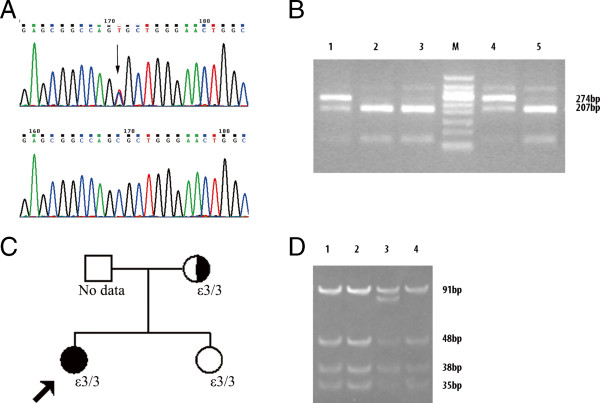Figure 2.

Mutation Detection, Genotyping of ApoE and Family Pedigrees of Patients with Lipoprotein Glomerulopathy (LPG) and TMA. Panel A shows DNA sequencing results of APOE exon 3 of the patient and a healthy control and the positions of the APOE Kyoto mutation (arrow). The LPG patient had a heterozygous C→T mutation leading to an amino acid substitution of Cys for Arg at codon 25 of apoE. Panel B shows the results of APOE Kyoto detection with PCR-RFLP analysis. Lanes 1 (the patient) and 4 (patient’s mother): the presence of 274 bp and 207 bp fragments indicate heterozygous mutation of APOE Kyoto. Lanes 2 (patient’s sister), 3 and 5 (healthy control): the presence of the 207 bp fragment indicates the wild-type homozygote. M: 100 bp molecular ladder. Panel D shows the results of genotyping with PCR-RFLP analysis. Lanes 1 (the patient), 2 (patient’s sister), and 4 (patient’s mother): the presence of 91 bp, 48 bp, 38 bp and 35 bp fragments indicates an ε3/3 genotype. Lanes 3 (control): the presence of 91 bp, 83 bp, 48 bp, 38 bp and 35 bp fragments indicates an ε2/3 genotype. M: pUC19 DNA/MspI marker. In Panel C, family pedigree for the patient indicates the APOE Kyoto genotype in probands (arrows) and family members from whom DNA was available. No other family members had clinical evidence of the disease. Men are represented by squares, and women by circles. The shading indicates patients with LPG. The patient’s mother is an asymptomatic APOE Kyoto carrier.
